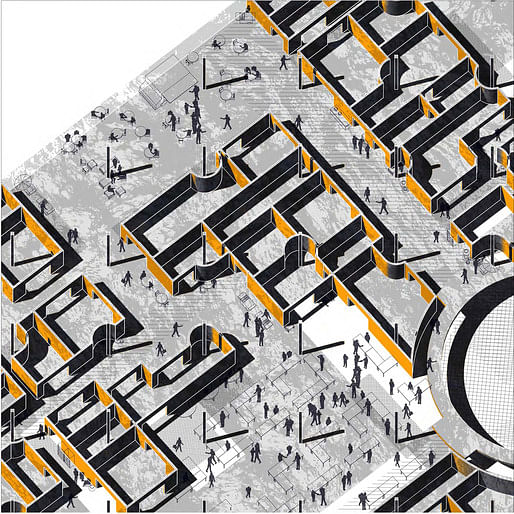
Oct '15 - Feb '16
It is easy to get lost amongst the cheaply made products that line the endless shopping aisles of giant chain stores. These over scaled super stores filter out character and quality in exchange for mass production. The white tiled floors and the overstocked shelves are identical to every other store, save the small scuff marks left behind by the hoards of people who trudge from aisle to aisle.
I refuse to accept this world of banality. I will not settle for monstrous parking lots, enormous warehouses, and disconnected, faceless consumers.
My 2015 Spring quarter presented a project to analyze a larger portion of the way society functions. In interdisciplinary groups (three architecture students and one landscape), we worked tasked to generate a system to accommodate a hotel, retail environment, and office spaces off on Sunset boulevard in West Hollywood, CA.

After a case study on the lavish stores on Rodeo Drive in Beverly Hills, my group and I retaliated with an interest in more naturally formed, community based ways to interact through architecture. Something we would classify as Informal. The project utilizes informality as a means to create dynamic, adaptive, and flexible environments. Within the project are many serendipitous spacial and social experiences due to odd pairings of unique stores. The project brings individual character and uniqueness into a high density mix of retail, commercial, and hotel spaces woven together by a common infrastructure of overlapped grids.

The best examples of informality are bazars, swap-meets and parking lots. What these spaces have in common are the use of a grid, a small repetitive module, and a system to remake and reconfigure. In cities, even as program and user change, the grid of parking lots and markets remain fixed. The grid is neutral system and as such it can take on many characteristics and behaviors.

We began this project by generating several grids. One related to the urban north and south grid of the city of the city and one parallel to Santa Monica Blvd. The resulting intersection forced a geometric response that loosened the monotony of the grid. As the grid conflicted with each other, we created circular anomalies that would allow local relationships such as gathering spaces and transitional areas.


 The first level is all retail with main circulation jointed with 3 distinct landscape. Intricacies of the plan allowed intimate pathways and small pockets of public space. Continuing the main circulation into the second level, the 10 by 10 office spaces organized themselves as clusters around communal conference rooms. The roof level was thickened and pathways were subtracted to join specific activities, such as croquet, bocce, and racquetball. The Hotel tower is located on Santa Monica Blvd and consists of different scale units for users with different agendas.
The first level is all retail with main circulation jointed with 3 distinct landscape. Intricacies of the plan allowed intimate pathways and small pockets of public space. Continuing the main circulation into the second level, the 10 by 10 office spaces organized themselves as clusters around communal conference rooms. The roof level was thickened and pathways were subtracted to join specific activities, such as croquet, bocce, and racquetball. The Hotel tower is located on Santa Monica Blvd and consists of different scale units for users with different agendas.

This project is a collection of individuals subject to change over time. Its layers architecturally communicate as a framework for the complexities of the individuals that make up the project. With individuality as the focus and driver of informality, we can stimulate personal identity within the context of a vibrant and unified community.
The images were created by my group mates Saul Meneses, Denise Nugent, Manny Zermeno, and I.



Five years ago when I entered the Architecture school I never thought of just how big my thinking could be in thinking about society. By no means am I calling myself an anthropologist or anything of that nature, but I am caught in the especially prevalent ideology of the architecture student.
2 Comments
I really like this project!!
Reminds me a little bit of this project:
http://johndavidtodd.com/Sometimes-alone-Mostly-with-others-A-Thesis-Proposal
http://archinect.com/lian/live-blog-john-david-todd-sometimes-alone-mostly-with-others-m-arch-i-thesis
Block this user
Are you sure you want to block this user and hide all related comments throughout the site?
Archinect
This is your first comment on Archinect. Your comment will be visible once approved.